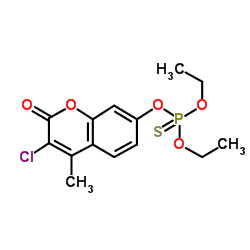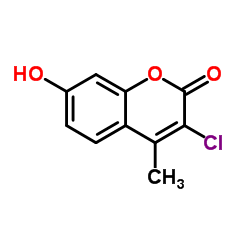蝇毒磷
一般危化品

蝇毒磷结构式
|
常用名 | 蝇毒磷 | 英文名 | Coumaphos |
|---|---|---|---|---|
| CAS号 | 56-72-4 | 分子量 | 362.766 | |
| 密度 | 1.4±0.1 g/cm3 | 沸点 | 449.9±55.0 °C at 760 mmHg | |
| 分子式 | C14H16ClO5PS | 熔点 | 91ºC | |
| MSDS | 中文版 美版 | 闪点 | 225.9±31.5 °C | |
| 符号 |


GHS06, GHS09 |
信号词 | Danger |
蝇毒磷用途Coumaphos is aorganothiophosphorus cholinesterase inhibitor that is used as an anthelmintic, insecticide, and as a nematocide. |
| 中文名 | 蝇毒磷 |
|---|---|
| 英文名 | coumaphos |
| 中文别名 | 香豆磷 | O,O-二乙基-O-(3氯-4-甲基香豆素-7)-硫代磷酸酯 | O,O-二乙基-O-(3-氯-4甲基香豆素-7)硫逐磷酸酯 | 库马磷 | 蝇毒硫磷 | 蝇毒 |
| 英文别名 | 更多 |
| 密度 | 1.4±0.1 g/cm3 |
|---|---|
| 沸点 | 449.9±55.0 °C at 760 mmHg |
| 熔点 | 91ºC |
| 分子式 | C14H16ClO5PS |
| 分子量 | 362.766 |
| 闪点 | 225.9±31.5 °C |
| 精确质量 | 362.014465 |
| PSA | 99.80000 |
| LogP | 3.86 |
| 外观性状 | 黄褐色或米色固体 |
| 蒸汽压 | 0.0±1.1 mmHg at 25°C |
| 折射率 | 1.578 |
| 储存条件 | 本品应密封保存。 |
| 稳定性 | Stable. Combustible. Incompatible with alkalies, strong oxidising agents. |
| 分子结构 | 1、 摩尔折射率:86.84 2、 摩尔体积(m3/mol):261.8 3、 等张比容(90.2K):709.5 4、 表面张力(dyne/cm):53.9 5、 极化率(10 -24cm 3):34.42 |
| 计算化学 | 1.疏水参数计算参考值(XlogP):4.5 2.氢键供体数量:0 3.氢键受体数量:6 4.可旋转化学键数量:6 5.互变异构体数量:无 6.拓扑分子极性表面积86.1 7.重原子数量:22 8.表面电荷:0 9.复杂度:500 10.同位素原子数量:0 11.确定原子立构中心数量:0 12.不确定原子立构中心数量:0 13.确定化学键立构中心数量:0 14.不确定化学键立构中心数量:0 15.共价键单元数量:1 |
| 更多 | 1. 性状:无色结晶。工业为棕色结晶 2. 密度(g/mL,25/4℃): 1.474 3. 相对蒸汽密度(g/mL,空气=1):未确定 4. 熔点(ºC):95℃ 5. 沸点(ºC,常压):未确定 6. 沸点(ºC,5.2kPa):未确定 7. 折射率:未确定 8. 闪点(ºC):未确定 9. 比旋光度(º):未确定 10. 自燃点或引燃温度(ºC):未确定 11. 蒸气压(kPa,25ºC):未确定 12. 饱和蒸气压(kPa,60ºC):未确定 13. 燃烧热(KJ/mol):未确定 14. 临界温度(ºC):未确定 15. 临界压力(KPa):未确定 16. 油水(辛醇/水)分配系数的对数值:未确定 17. 爆炸上限(%,V/V):未确定 18. 爆炸下限(%,V/V):未确定 19. 溶解性:微溶于水 |
2.对环境的影响: 一、健康危害 侵入途径:吸入、食入、经皮吸收。 健康危害:本品为高毒有机磷杀虫剂。能使全血胆碱酯酶活性下降,引起头痛、头晕、无外国籍、烦燥、恶心、呕吐、出汗、流涎、瞳孔缩小、抽搐、呼吸困难、紫绀,重者常伴有肺水肿、脑水肿,可死于呼吸衰竭。 二、毒理学资料及环境行为 毒性:对人畜高毒。 急性毒性:LD5013mg/kg(大鼠经口);28mg/kg(小鼠经口);860mg/kg(大鼠经皮) 危险特性:遇明火、高热可燃。受高热分解,放出高毒的烟气。 燃烧(分解)产物:一氧公碳、二氧化碳、氯化氢、氧化硫、氧化磷。 3.现场应急监测方法: 4.实验室监测方法: 气相色谱法《固体废弃物试验分析评价手册》中国环境监测总站等译 5.环境标准: 前苏联(1975) 水体中有害有机物的最大允许浓度 1.0mg/L 联合国规划署(1974)保护水生生物淡水中农药的最大允许浓度 0.001μg/L 6.应急处理处置方法: 一、泄漏应急处理 隔离泄漏污染区,周围设警告标志,建议应急处理珍员戴自给式呼吸器,穿化学防护服。不要直接接触泄漏物,避免扬尘,收集于干燥净洁有盖的容器中,倒至空旷地方深埋。也可以用大量水冲洗,经稀释的洗水放入废水系统。如大量泄漏,收集回收或无处理后废弃。 二、防护措施 呼吸系统防护:生产操作或农业使用时,佩戴防毒口罩。紧急事态抢救或逃生时,应该佩戴自给式呼吸器。 眼睛防护:戴化学安全防护眼镜。 防护服:穿相应的防护服。 手防护:戴防化学品手套。 其它:工作现场禁止吸烟、进食和饮水。工作后,淋浴更衣。工作服不要带到非作业场所,单独存放被毒物污染的衣服,洗后再用。注意个人清洁卫生。 三、急救措施 皮肤接触:用肥皂水及清水彻底冲洗。就医。 眼睛接触:拉开眼睑,用流动清水冲洗15分钟。就医。 吸入:脱离现场至空气新鲜处。呼吸困难时给输氧。呼吸停止时,立即进行人工呼吸。 食入:误服者,饮适量温水,催吐。洗胃。就医。合并使用阿托品及复能剂(氯磷定、解磷定)。 灭火方法:泡沫、干粉、砂土、二氧化碳。 |
| 符号 |


GHS06, GHS09 |
|---|---|
| 信号词 | Danger |
| 危害声明 | H300-H312-H410 |
| 警示性声明 | P264-P273-P280-P301 + P310-P501 |
| 个人防护装备 | Eyeshields;Faceshields;Gloves;type N95 (US);type P1 (EN143) respirator filter |
| 危害码 (欧洲) | T+: Very toxic;N: Dangerous for the environment; |
| 风险声明 (欧洲) | R21;R28;R50/53 |
| 安全声明 (欧洲) | S28-S36/37-S45-S60-S61-S36-S26-S16 |
| 危险品运输编码 | 2783 |
| RTECS号 | GN6300000 |
| 包装等级 | II |
| 危险类别 | 6.1(a) |
(1)200g乙酰乙酸乙酯及270g SO2CI2,分别溶于100ml苯中,然后在10℃时,将SO2CI2苯溶液滴入乙酰乙酸乙酯苯溶液中而得。(2)将间苯二酚88g和α-氯化乙酰乙酸乙酯132g滴加640ml浓硫酸中,温度在5℃以下进行反应而得3-氯-4-甲基-7-羟基香豆素。将44g 3-氯-4-甲基-7-羟基香豆素,29g无水碳酸钾同置於500ml甲乙酮中,在回流和搅拌下,滴加40g O,O-二乙基硫代磷酰氯,回流2h而得蝇毒磷。
|
Genomic analysis of the interaction between pesticide exposure and nutrition in honey bees (Apis mellifera).
J. Insect Physiol. 71 , 177-90, (2014) Populations of pollinators are in decline worldwide. These declines are best documented in honey bees and are due to a combination of stressors. In particular, pesticides have been linked to decreased... |
|
|
Photodegradation of organophosphorus pesticides in honey medium.
Ecotoxicol. Environ. Saf. 108 , 84-8, (2014) Honey can be polluted due to environmental pollution and misuse of beekeeping practices. In the present study, photodegradation experiments of organophosphorus pesticides (coumaphos, methyl parathion ... |
|
|
Honey constituents up-regulate detoxification and immunity genes in the western honey bee Apis mellifera.
Proc. Natl. Acad. Sci. U. S. A. 110(22) , 8842-6, (2013) As a managed pollinator, the honey bee Apis mellifera is critical to the American agricultural enterprise. Recent colony losses have thus raised concerns; possible explanations for bee decline include... |
| Agridip |
| Coumaphos |
| Meldone |
| Baymix |
| Phosphorothioic acid, O- (3-chloro-4-methyl-2-oxo-2H-1-benzopyran-7-yl) O,O-diethyl ester |
| 3-chloro-7-diethoxyphosphinothioyloxy-4-methylcoumarin |
| Asuntol |
| 3-Chlor-7-diaethoxythiophosphoryloxy-4-methyl-cumarin |
| Meldane |
| Azunthol |
| Phosphorothioic acid, O-(3-chloro-4-methyl-2-oxo-2H-1-benzopyran-7-yl) O,O-diethyl ester |
| 3-chloro-7-diethoxythiophosphoryloxy-4-methyl-coumarin |
| EINECS 200-285-3 |
| Coumaphos [BAN] |
| O-(3-Chlor-4-methyl-2-oxo-2H-chromen-7-yl)-O,O-diethylthiophosphat |
| O-(3-chloro-4-methyl-2-oxo-2H-1-benzopyran-7-yl) O,O-diethyl phosphorothioate |
| Muscatox |
| Thiophosphate de O-(3-chloro-4-méthyl-2-oxo-2H-chromén-7-yle) et de O,O-diéthyle |
| O-(3-chloro-4-methyl-2-oxo-2H-chromen-7-yl) O,O-diethylphosphorothioate |
| 3-chloro-7-diethoxyphosphinothioyloxy-4-methylchromen-2-one |
| O-3-chloro-4-methyl-2-oxo-2H-chromen-7-yl O,O-diethyl phosphorothioate |
| O-(3-Chloro-4-methyl-2-oxo-2H-chromen-7-yl) O,O-diethyl phosphorothioate |
| Asunthol |
| Coumafos |
| MFCD00041820 |



 CAS号2465-65-8
CAS号2465-65-8